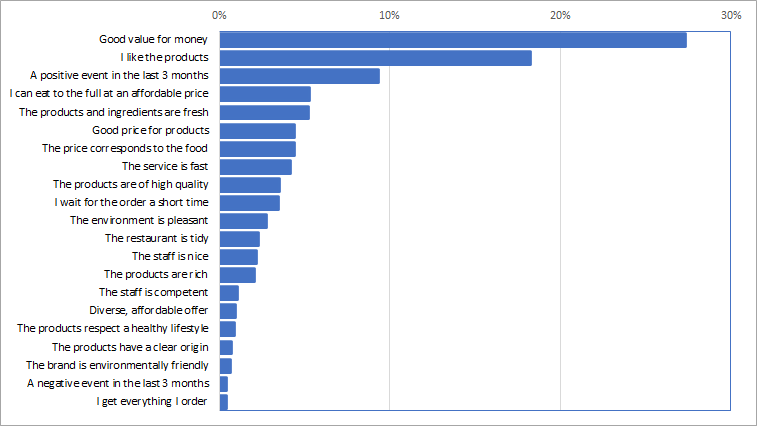Emotions produce behavior.
Doe Tempo (2018)
Abstract
Current commercial market research often focuses on evoked perceptual and emotional attributes of objects, such as products, services, brands, institutions, etc. To estimate the influence of such attributes on the acceptability, a model of the value conjoint analysis can be used. The distinct characteristic of the method is the importance of attributes being derived from the behavior, be it real or expected, rather than being a summary of subjective statements on the attributes. Analysis of perceptional aspects of fast-food chain brands is given as an example.
The differences in the functional and user properties of marketed products are not recognizable before the products are used. The actual purchase decision is often based on perception. Perceptual and emotional attitudes, which the product and its provider (brand) evoke in the consumer, are collectively referred to as the image.
To understand what drives or strengthens customer loyalty, and be able to improve the image by marketing means, requires knowledge of the influence of evoked attitudes. The results of commercial market research usually present the shares of respondents who assign certain attributes to the object. A typical questionnaire design and study results can be found in Qualtricks International, Inc. page, and sample video.
The importance of an attribute can be obtained as an answer from a direct question. However, respondents have a tendency to focus on the rational aspects or to assign too many aspects as important. Softer or irrational issues are often underrated or disregarded. Consequently, the obtained view may not reflect reality.
Besides semi-quantitative procedures (eg. free association method, brand concept maps, user-generated content, etc.), exact procedures have been suggested to estimate the influence of image attributes on the success of the offer. One of them is factor analysis, which makes visible the relationships between the evaluation of the studied objects and their attributes. Unfortunately, it is difficult to translate the results (rotated factors, their communalities, factor loads of variables, and other measures) into managerial language and decisions. The method of structured equations (SEM - Structure Equation Modeling) requires a prior definition of path concatenations between explanatory and explained variables from the analyst. The procedure based on multiple multidimensional linear regressions is often unstable due to common correlations among the explanatory variables. Consequently, the regression coefficients tend to have unexpected values or erroneous signs. This is avoided in GSCA - Generalized Structured Component Analysis developed by Hwang et.al (2017). These and related procedures are almost exclusively a subject of academic studies.
The methodology of commercial research lacks a quick and simple method for estimating the unbiased importance of image characteristics, i.e their influence on acceptability, and thus the potential success of a product on the market.
An important tool of market research for optimizing product properties has been the conjoint analysis method based on the decisions of consumers reacting to the sets of products with properly set product properties. As the influence of perceptual and emotional attitudes on product selection and choice has increased, the usability of conjoint analysis has decreased because the attitudes are evoked and cannot be set. However, there is a way to reverse the procedure. Instead of setting a value of a product attribute, one can ask what value of a particular attribute the object or product evokes. This approach is inherent to the traditional questionnaire. The obtained response can be used as the attribute level of a conjoint profile. Thus, the design plan is not generated in advance, but is designed using the evoked attitudes of respondents.
To estimate the influence of evoked attributes, it is of advantage to use the theoretical model of CVA - Conjoint Value Analysis, and the related mathematical apparatus. Data are analyzed as a regression of the acceptability of concepts on explicit and evoked attributes. The effect of an attribute can be expressed as the ratio of the importance of the attribute to the summed importance of all attributes.
 As
aside
As
aside
The way of interviewing image attributes has stabilized in market research. A summary and properties of 12 different interviewing variants are given in Plumeyer, Anja et al. (2019). The minimal number of tested objects and maximal number of attributes is, as in any other mathematical-statistical procedure, limited by the requirements for accuracy and precision.

The explained (dependent) variable is most often the probability of purchase or acquisition (PI - Purchase Intention), repeated purchase, willingness to continue the service, etc., or a combination thereof. Usually, they are obtained from the evaluation of the objects or their concepts. Reliability of the values is very important. Therefore, the assessment should be on at least a 5-point scale. Scales with more than 10 degrees rarely work because the respondent usually uses only part of the scale (usually no more than 5 to 7 points) of the scale. It is advantageous to construct the explanatory variable from several answers, e.g. as a weighted average of willingness to buy, willingness to recommend, and willingness to repeat the purchase, thus increasing the reliability of the evaluation.

Usually, several tens of perceptual and emotional attributes are queried. If some of them are considered important, it is advisable to use at least a 3-point scale to evaluate them (e.g. 1 - worse than most, 2 - about average, 3 - better than most). For low important attributes, it is possible to use dichotomous evaluation (0 - does not have this property, 1 - has this property) in two-dimensional check-box grids of attributes by objects.
The respondent can evaluate the studied objects one by one. In this arrangement the interviewing is resembling the classic test of objects with either one (e.g. brand) or a few explicit attributes (e.g. brand, model, and price). The evaluation of the object is then completed with questions about evoked perceptions and emotions.
In case of a single explicit attribute, typically the brand, discrimination between objects can be increased by letting the respondent to select the appropriate objects for each of the attributes. This approach is far more efficient to discriminate between objects than the assignment of appropriate attributes to each of the objects independently. The respondent should not be able to mark more than half of the objects for each attribute. Forced answers should be avoided. The ranking of objects for each of the attributes would further strongly add to the efficiency.
Purely theoretically, different evaluation methods and scales can be used in the same exercise, but evaluation on more rating levels or ranks will, in general, gain more importance because the information content increases with the accuracy of the variable.
The distinct characteristic of the method is the importance of attributes being derived from the behavior, be it real or expected, rather than being a summary of subjective statements on the attributes.
An older study of image attributes for several fast-food chain brands was selected to test the procedure.
The explained variable was constructed as the average of (1) the overall satisfaction, (2) recommendation to friends, and (3) willingness to repeat a visit to the chain outlet as obtained from 5-step Likert scale questions for the brands known to the respondent.
Of the explanatory variables, only the "Good value for money" question had a 5-point scale. All other answers were dichotomous and were obtained from check-box grid questions. The respondent had to check at least one attribute for each of the brands. No other limitations were imposed.
The explained variable was analyzed as if obtained from a CVA - Conjoint Value Analysis. All attributes were given the same prior weights and starting values. The computed importance of attributes is shown in the picture below.

The resulting order of attribute importance does not raise significant doubts. At the same time, the question arises as to what fast-food customers consider to be the "value" and how the target groups differ in this respect.
The success of a brand is affected by the perceptional importance of a certain attribute only if that perception
has a sufficient share in the market. The importance of attributes should, therefore, be shown in parallel with
the perception shares. The multiplication product of both quantities (and, possibly, their normalization to the
sum of 100%) can provide values of the market power of the attributes.
In addition to the aggregated results, the procedure allows comparing the influence of the attributes of two
objects, such as the client's and the closest competitor's ones. We do not provide such a view due to the
confidentiality of the results.
Preparation and processing data is a routine process that takes an experienced analyst about one business day.
Hwang, H., Takane, Y., and Jung, K. (2017): Generalized Structured Component Analysis with Uniqueness Terms for Accommodating Measurement Error. Front. Psychol., 8, 2137 (on-line publication).
Plumeyer, Anja, Kottemann, P., Böger, D, and Decker, R. (2019): Measuring brand image: a systematic review, practical guidance, and future research directions. Review of Managerial Science, 13(2), pp. 227–265.